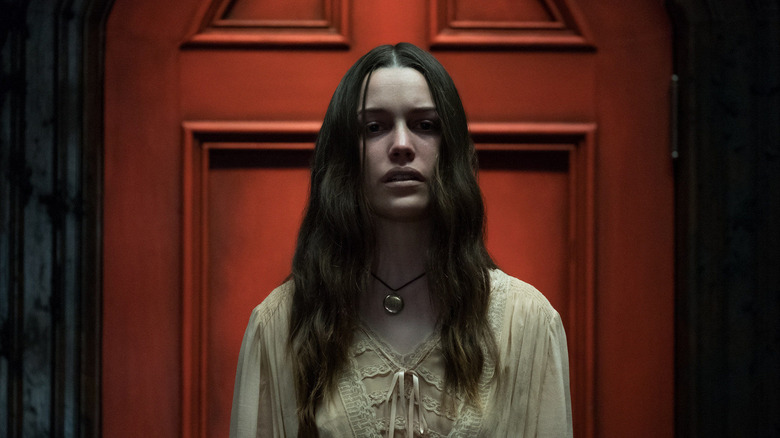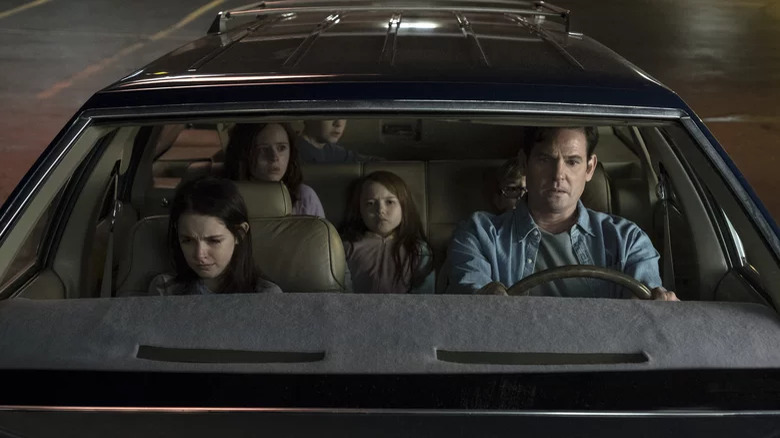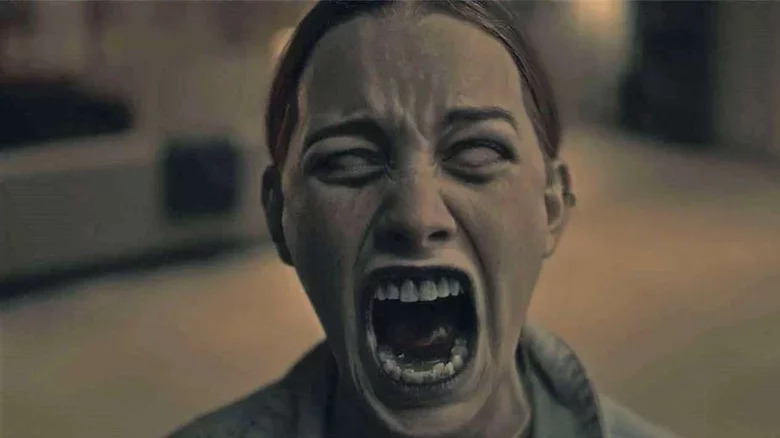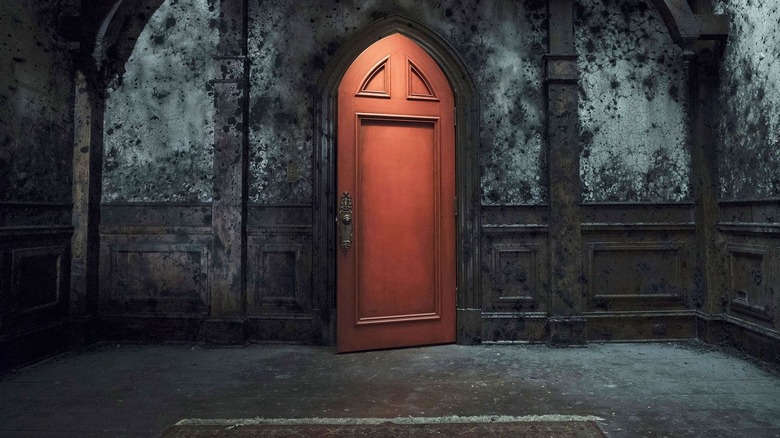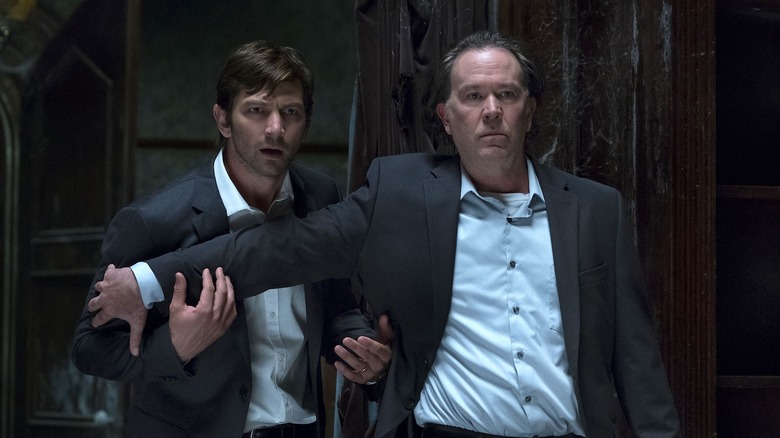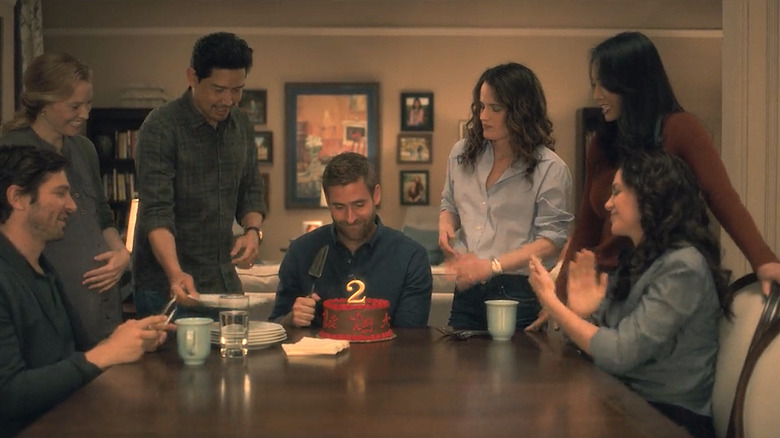The Haunting Of Hill House Ending Explained: And Those Who Walk There Walk Together
Mike Flanagan had already made a name for himself by carving out a little niche in highly emotional horror movies before he (loosely) adapted Shirley Jackson's "The Haunting of Hill House" into the Netflix series of the same name. However, it was that show that became his masterpiece.
The series follows the fractured Crain family as they deal with trauma across two timelines. We follow them as adults in the aftermath of the suicide of one of their own, and as kids living in what would later come to be known as the most haunted house in the country. Through a non-linear narrative, "The Haunting of Hill House" explores the mysteries of what happened in the titular house and the ghosts that the Crain kids may or may not have seen growing up, as well as the long-lasting traumas and resentments born out of their time in the house.
The result is a scary-as-hell TV show (with one of the best jump scares in recent memory), but what sets "The Haunting of Hill House" apart is its profound exploration of grief and trauma and how that connects to the ghost story. Because of the mystery approach to the story, and the way the show plays with whether the ghosts are real or not, the ending of the show continues to make fans debate exactly what happened and what it means. This is why we're putting our foot down and telling the definitive account of what happened at the end of "The Haunting of Hill House" and what it means, exactly.
What you need to remember about the plot of The Haunting of Hill House
Though "The Haunting of Hill House" isn't strictly a mystery show, the show's format and the non-linear narrative do build up a very compelling set of questions that slowly unravel throughout the season. There's the question of what exactly happened at Hill House and whether it actually was haunted. But there's also the mystery surrounding the death of the Crain children's mother (which was never really explained to them), why their father Hugh kept her death secret, and why he never tore down the house.
The more we learn about the events of the past, and the more time we spend with the adult Crains (Steven, Luke, Neill, Theo, and Shirley) coping with said events, the more the tragedy of the Crain family becomes evident. We slowly learn that the youngest kids, Luke and Nell, were terrified of ghosts they saw every night while at Hill House, which the rest of the family mostly ignored. Nell grew up depressed and manic while Luke became a heroin addict. We also learn that Steven, the older brother who never really saw any ghosts or believed in the tales as a kid, grew up to write a successful memoir that sold their story as a haunted house tale.
Following Nell's suicide, Luke runs aways from rehab and eventually makes his way back to Hill House to destroy it, believing it to be the cause of all their misfortune.
Then there's the story of the house itself, which we learn had many a strange death occur within its walls (like the original owner William Hill, who bricked himself up behind a wall in the basement in the '40s). If the possibility of ghosts wasn't enough, there's also the fact that the house was infected with mold, which could cause hallucinations — like seeing ghosts everywhere.
What happened at the end of The Haunting of Hill House
In the final episode, the entire surviving Crain family gathers at Hill House to try and save Luke before he dies by suicide — or so they think. Instead, they find him in the mysterious Red Room that they all thought was always locked when they lived in the house, but was actually always open to them, in different ways. The Red Room is actually the stomach of the house, which appeared in different forms (a reading room, a treehouse) to appeal to each kid, and it traps them in visions so they stay in the house forever like so many other ghosts.
Except, along comes the ghost of Nell, who saves her siblings and wakes them up from their visions, allowing them to see Luke slowly dying from injecting himself with rat poison while manipulated by a vision. Thanks to Nell, they are able to forgive each other for being crappy siblings and vow to stop being unreasonably angry at one another. While Shirley and Theo drive Luke up to the hospital, Steven, the skeptic son who nevertheless was the one who saw the most ghosts, including the ghost of her mother, sees his father one last time, as the only way he managed to get them free from the clutches of the house was to sacrifice himself, staying behind as a ghost, trapped in Hill House forever.
The rest is confetti
While the show never properly explains how the house works or why it is evil, we just accept that it is so. Everyone who enters is doomed in some way. The house's goal seems to simply be to trap as many souls within itself as possible, with the Red Room serving as a way for the house to feed off the trauma and misery of its inhabitants. It isolated the Crain kids, and it also isolated their mother, Olivia, whose fate is finally revealed. Whether it actually was the ghost of William Hill's wife that drover her to her death, or the mold from the house, Olivia started seeing ghosts one day, and eventually became convinced that the only way to keep her children safe from the dangers of the outside world was to prevent them from ever seeing the outside world.
And so, we finally find out what happened the day the Crains left Hill House and Olivia died. Turns out Olivia had Nell, Luke and his "imaginary friend" Abigail Dudley (who was actually the daughter of the house's caretakers, the Dudleys) over for a tea party in the Red Room, where she tried to poison all three kids. Thankfully, Hugh stopped it, but not before Abigail drank the poisoned tea, and took the Crain children away.
He never told them what happened because, honestly, would you tell your young children that their mother tried to poison them? Hugh later returned to the house to find Olivia, only to discover she had killed herself, and rather than destroy the house he made a pact with the Dudleys that they'll keep the murder-suicide a secret in exchange for the house remaining as is, so they can visit their daughter's ghost.
What the end of The Haunting of Hill House means
Even if the finale of "The Haunting of Hill House" makes the ghost aspect more explicit, the show still works as just a tale of grief and trauma and a family broken apart due to mental illness and suicide. On a rewatch, the show works even better because you see how avoidable the tragedy of the Crains was. Even without ghosts, Hugh and Olivia Crain failed to realize their kids were terrified of the house, which could have prevented several traumas in their adult lives. They also failed to realize and deal with Olivia's mental illness even before she became a victim of Poppy Hill's manipulation, while in the present, Luke denied his past so much, like the other siblings, that they failed to realize Luke and Nell's trauma before it was too late. Even the house's caretakers could have been more open about the weird occurrences at Hill House, which would have spared the Crains so much pain.
And yet, while the ghost story is a disturbing and scary one, it also provides the show with a deep sense of hope and optimism, because all the ghosts of the people who died at Hill House can be together forever. We see this at the end when Mr. Dudley carries his dying wife to the property so she can be together with their daughter. We also see this in the show's cheerful twist on Shirley Jackson's opening paragraph from her novel:
"Within, walls continue upright, bricks meet neatly, floors are firm, and doors are sensibly shut. Silence lay steadily against the wood and stone of Hill House. And those who walk there walk together."
What Mike Flanagan has said about the ending
Though "The Haunting of Hill House" works when read as a straight-up drama about suicide and trauma or as an actual ghost story, there isn't much in terms of alternate theories or endings — with one big exception.
After the show's premiere, Flanagan explained that he came very close to adding a final twist that would rob the Crains of salvation. Indeed, the big clue as to the nature of the Red Room was that each of its forms share a single vertical window. In the final scene of the series, we see the surviving Crains celebrating Luke's second year of sobriety, a happy ending that shows them healing and moving on. Flanagan, however, almost framed it very differently. He explained:
"One thing I can say is that we talked for a very, very long time about putting the Red Room window, that weird vertical window, in the background of this shot. And I ultimately decided not to. It was too cruel. But there was a lot of talk that this peace might not be real. In the version we ended up going with, I think it absolutely is real. We committed to that course of action."
Even Luke's actor, Oliver Jackson-Cohen, believes that is the show's true ending, i.e. all the Crains are trapped in the Red Room. As Jackson-Cohen told The Wrap, "Whenever each child, each sibling, is in the Red Room, something in the fantasy is red," he said. "And so there's something at the end — it was Kate [Siegel], who plays Theo, who kind of pointed it out to me — with Luke's sobriety cake, she said the cake is red."
